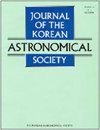星系团外围弱球形激波的射电辐射
IF 0.8
4区 物理与天体物理
Q3 ASTRONOMY & ASTROPHYSICS
引用次数: 19
摘要
在Kang(2015)中,我们计算了预计在星团外围形成的弱球形冲击下宇宙射线电子的加速度,并估计了这些电子发出的漫射同步辐射。我们证明,在减速的球形激波下,电子和辐射的体积积分谱明显偏离恒定平面激波的测试粒子幂律,因为激波压缩比和注入电子的通量随时间减小。在本研究中,我们考虑球形爆炸波通过被p∝r ?n等温晕包围的等密度核心传播,以探索冲击的减速如何影响加速电子的射电发射。通过假设球壳上的带状激波表面和相关的相对论性电子下游区域,计算了模型激波的表面亮度分布和体积积分无线电频谱。当冲击后磁场强度约为0.7或7 μG时,冲击年龄为~ 50 Myr时,体积积分无线电频谱逐渐变陡,频谱指数从α inj到α inj + 0.5 / 0.1?10 GHz,其中α inj为扩散激波加速度理论所期望的激波位置的注入指数。这种逐渐变陡可以解释A2266星系团中无线电遗迹的弯曲无线电频谱,Trasatti等人(2015)将其解释为一个破幂律,如果遗迹激波足够年轻,以至于破频率在1 GHz左右。本文章由计算机程序翻译,如有差异,请以英文原文为准。
RADIO EMISSION FROM WEAK SPHERICAL SHOCKS IN THE OUTSKIRTS OF GALAXY CLUSTERS
In Kang (2015) we calculated the acceleration of cosmic-ray electrons at weak spherical shocks that are expected to form in the cluster outskirts, and estimated the diffuse synchrotron radiation emitted by those electrons. There we demonstrated that, at decelerating spherical shocks, the volume integrated spectra of both electrons and radiation deviate significantly from the test-particle power-laws predicted for constant planar shocks, because the shock compression ratio and the flux of inject electrons decrease in time. In this study, we consider spherical blast waves propagating through a constant density core surrounded by an isothermal halo with p ∝ r ?n in order to explore how the deceleration of the shock affects the radio emission from accelerated electrons. The surface brightness profile and the volumeintegrated radio spectrum of the model shocks are calculated by assuming a ribbon-like shock surface on a spherical shell and the associated downstream region of relativistic electrons. If the postshock magnetic field strength is about 0.7 or 7 μG, at the shock age of ∼ 50 Myr, the volume-integrated radio spectrum steepens gradually with the spectral index from α inj to α inj + 0.5 over 0.1?10 GHz, where α inj is the injection index at the shock position expected from the diffusive shock acceleration theory. Such gradual steepening could explain the curved radio spectrum of the radio relic in cluster A2266, which was interpreted as a broken power-law by Trasatti et al. (2015), if the relic shock is young enough so that the break frequency is around 1 GHz.
求助全文
通过发布文献求助,成功后即可免费获取论文全文。
去求助
来源期刊

Journal of the Korean Astronomical Society
地学天文-天文与天体物理
CiteScore
1.30
自引率
10.00%
发文量
0
审稿时长
>12 weeks
期刊介绍:
JKAS is an international scientific journal publishing papers in all fields of astronomy and astrophysics. All manuscripts are subject to the scrutiny of referees. Manuscripts submitted to JKAS must comply with the ethics policy of JKAS. Six regular issues are published each year on February 28, April 30, June 30, August 31, October 31, and December 31. One year''s issues compose one volume.
 求助内容:
求助内容: 应助结果提醒方式:
应助结果提醒方式:


